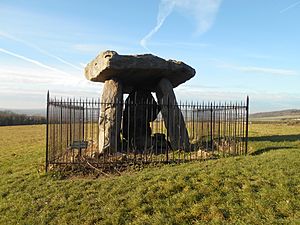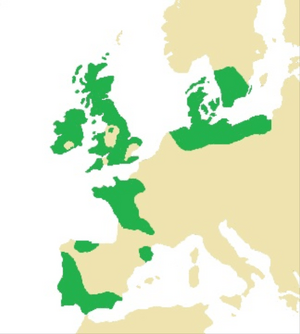Kit's Coty House facts for kids

The monument with the Medway Valley behind
|
|
| Lua error in Module:Location_map at line 420: attempt to index field 'wikibase' (a nil value). | |
| Type | Long barrow |
|---|---|
Kit's Coty House is an amazing ancient tomb found near Aylesford in Kent, England. It's a type of burial place called a chambered long barrow. People built it around 4000 BCE, which was during the Early Neolithic period. Today, it's still standing, but it looks a bit ruined.
Experts who study old things, called archaeologists, believe that early farming communities built this monument. These people had just started using agriculture in Britain. Kit's Coty House is part of a bigger group of similar tombs called the Medway Megaliths. These are found near the River Medway. Other tombs nearby include Little Kit's Coty House and the Coffin Stone. On the other side of the river, you can find Addington Long Barrow, Chestnuts Long Barrow, and Coldrum Long Barrow.
Kit's Coty House was one of the first ancient sites in Britain to be protected by the government. Now, English Heritage looks after it, and you can visit it all year round. You can walk to Kit's Coty House along a path where the Pilgrim's Way and Rochester Road meet. Iron railings surround the main stone chamber. It's about 2 kilometers (1.2 miles) north of Little Kit's Coty House.
The name "Kits Coty" might mean "Tomb in the Forest." This comes from an old British word, *kaitom, which means "forest." A village in Canada, Kitscoty, is even named after this site! Some people get confused by the word "House" in the name, expecting a normal building. But it's actually an ancient burial chamber.
Contents
What is the Neolithic Period?
The Early Neolithic period was a time of big changes in Britain. Between 4500 and 3800 BCE, people started to farm instead of just hunting and gathering food. This new way of life came from other parts of Europe. Kent was an important place for new settlers and visitors because it was close to Europe and had the River Thames.
Britain was mostly covered in forests during this time. Most of Kent stayed forested until the Late Bronze Age, much later. Evidence from nearby areas suggests that the land around Kit's Coty House was also heavily forested. Archaeologists think that early Neolithic people in Britain mostly raised cattle. They probably moved around a lot, rather than staying in one permanent home.
Understanding Medway Megaliths
In Western Europe, the Early Neolithic was the first time people built huge structures in the landscape. These included chambered long barrows. These were long, rectangular mounds of earth with a special chamber built inside. Some chambers were made of wood, but others used very large stones called "megaliths."
These long barrows were often used as tombs. They held the bodies of many people from the community, not just one person. This tradition of building stone tombs spread across Western Europe. It came to Britain from Europe around 4000 BCE. Even though some stone buildings existed before this, these chambered long barrows were the first widespread use of stone in construction.
The Medway Megaliths are now in ruins, but they were once very impressive. They were some of the biggest and most noticeable tombs in Britain. They are found along the River Medway in the North Downs. They are the most southeastern group of megalithic monuments in Britain. Experts say they are some of the most interesting and well-known ancient sites in Kent.
The Medway Megaliths are split into two groups. One group is west of the River Medway, and the other is on Blue Bell Hill to the east. The two groups are about 8 to 10 kilometers (5 to 6 miles) apart. The western group includes Coldrum Long Barrow, Addington Long Barrow, and the Chestnuts Long Barrow. The eastern group has Smythe's Megalith, Kit's Coty House, Little Kit's Coty House, and the Coffin Stone. We don't know if they were all built at the same time. We also don't know if they were all used for the same purpose.
All the Medway long barrows share a similar design. They are all lined up from east to west. Each one had a stone chamber at the eastern end of the mound. They probably also had a stone front at the entrance. Their chambers were very tall, up to 3.0 metres (10 feet). This made them taller than most other long barrows in Britain.
These chambers were built from sarsen stone. Sarsen is a very hard and strong stone found naturally in Kent. Early builders would have found these stones nearby and moved them to the building site. These shared features show that the Medway Megaliths were a unique local style. However, they were still part of a larger European tradition of building stone tombs.
How Kit's Coty House Was Built
What you see today at Kit's Coty House is three large stones with a capstone on top. The entrance to the tomb is shaped like an "H." It's made of sarsen stone. Three upright stones, called orthostats, support a large flat stone on top, called a capstone. This gives you an idea of how big the original structure was. The front part of the chamber and any decorative front pieces are now gone.
The original mound of earth and the ditches around it have mostly been flattened by farming. However, you can still see them in aerial photos. A survey in 1981 found that the mound was about 70 meters (230 feet) long and 1 meter (3.3 feet) high. It might have been around 80 meters (262 feet) long originally. It was also likely 11 to 15 meters (36 to 49 feet) wide. Dark soil suggests there was a wide ditch on the south side.
Archaeologists have found pieces of old pottery in the soil around the barrow. In 1897, a leaf-shaped arrowhead, likely from the Neolithic period, was found nearby.
The General's Tombstone
At the western end of the monument, there was another large stone called "the General's Tombstone." This stone was destroyed in 1867. It might have been part of the long barrow's original structure.
Old Stories and Modern Beliefs
In 1722, a historian named Hercules Ayleway wrote about a local belief. People thought that Kit's Coty House and Little Kit's Coty House were built to remember two kings of Kent who died in battle.
In 1946, another local story was recorded. It said that three witches who lived on Blue Bell Hill built the chamber at Kit's Coty House. A fourth witch supposedly helped them put the capstone on top.
Today, some modern Pagan religions, like Druidry, use the Medway Megaliths for their ceremonies. Some Druid groups have held events at Kit's Coty House.
Studying Kit's Coty House
Kit's Coty House was mentioned in old books as early as the 1500s. In 1586, William Camden wrote about it in his book Britannia. He shared the popular idea that it was the tomb of a British prince named Catigern, who supposedly died in a battle in 455 AD.
In 1590, a group of historians visited the site. One of them, John Stow, described it as "one great flat stone in the mydst standinge up right, & ij othar the lyke or greatar stones, on eche syd one... and then one greatar flat stone lyenge flat over and above the othar thre." He also mentioned another large stone nearby.
Another historian, William Lambarde, compared Kit's Coty House to Stonehenge in his book in 1596.
In 1722, William Stukeley visited the site and drew pictures of it when it was still mostly complete. Before him, Samuel Pepys also saw it and wrote that it was "a thing of great antiquity." Stukeley included drawings of Kit's Coty House in his books. One drawing from 1722 showed the chamber, the mound, and the General's Tombstone.
In 1880, archaeologist Flinders Petrie listed the stones at Addington as part of Kent's ancient earthworks. In 1893, George Payne described Kit's Coty House as a "fallen cromlech" (an old term for a stone circle or tomb). He noted other large stones nearby, suggesting they were part of this monument or another one.
The famous author George Orwell visited the site on August 21, 1938. He described it as "a druidical altar or something of the kind." He thought the stones were on top of a high hill, but they are actually lower down on Blue Bell Hill.
In 1981, the Kent Archaeological Rescue Unit surveyed the site to learn more about it.
Managed by English Heritage
Kit's Coty House is considered "the best known" of the Medway Megaliths. It is also called "perhaps the best-known monument in Kent." Experts in 2005 called it an "important monument" and "amongst the best known in Britain."
See also
 In Spanish: Kit's Coty House para niños
In Spanish: Kit's Coty House para niños





